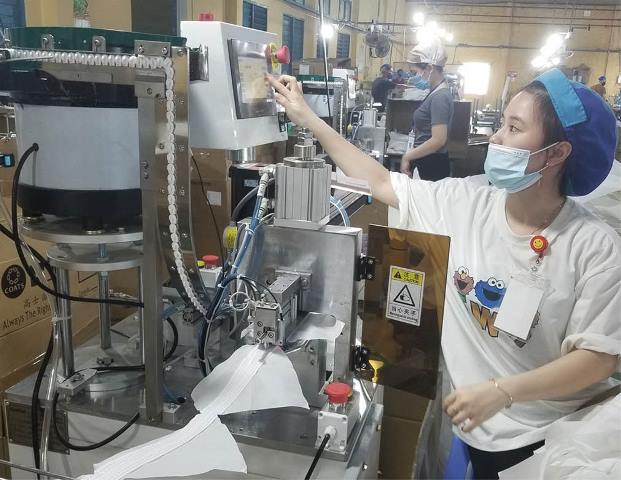
Many textile and garment manufacturing enterprises have innovated technology to improve productivity and fulfill their partners' orders.
A multi-target arrow
As an enterprise specializing in the production of essential oils and massage oil products, with monthly consumption of up to more than one ton of essential oil products of all kinds, Kim Vui Essential Oil Production Co., Ltd always focuses on investing in modern equipment for production, contributing to improving productivity and product quality. In particular, the essential oil filling line is the first advanced equipment selected by the enterprise to invest.
According to Mr. Tran Van Luc, Chairman of the Board of Directors, the investment of over 1 billion VND in equipping a semi-automatic essential oil filling line for the filling of essential oils not only contributes to improving productivity, reducing costs, and benefiting the environment but also creates quality products, catching up with consumers' trends.
After 17 years of establishment, the period from the beginning of this year to now is favorable for Hue Leather and Footwear Joint Stock Company as orders have continuously increased and contracts have been signed six months in advance. These are mainly manufactured export products for IKEA Group (Sweden), with monthly orders of about 300,000 sets of products, achieving revenue of over 60 billion VND.
Mr. Tran Ngoc Hai, Head of the Company's Human Resources Department, said that IKEA is a large corporation specializing in providing household products worldwide. Hence, the orders from this company are always stable. To meet the partners' orders as well as improve product quality and reduce labor, the enterprise is currently investing in an automatic sewing machine system, giving productivity that is five times higher than the previous machine.
Reducing labor pressure
Through research, the common point after investing in innovation, upgrading lines, and modern technological equipment is that it contributes to helping businesses increase labor productivity and product quality, reducing pressure on the lack of labor resources, lowering the cost of products, and increasing the productivity competitiveness.

Hue Leather and Footwear Joint Stock Company invests in high-tech sewing lines to improve productivity and reduce labor.
A preliminary survey in the process of assessing provincial competitiveness showed that the percentage of enterprises promoting investment in technology modernization increased. Particularly, the enterprises in the producing and manufacturing sector of electrical equipment, electronics, food processing are the industries with the highest automation rate in the past three years.
Enterprises in the fields of the garment, leather goods production, and construction have only applied technology modernization in the direction of automating less than 5% of the work since they still make the most of the cost advantage from cheap labor. Notably, thanks to applying similar technologies to production activities, many domestic enterprises have caught up with FDI enterprises in integrating into global supply chains effectively.
According to Mr. Tran Van My, General Director of Scavi Hue Company, investing in high-tech export garment production lines not only improves productivity and product quality but also reduces the needed labor as it is currently challenging to recruit garment workers. Soon, the enterprise will continue to consider and invest capital in renewing production lines and equipping modern facilities to meet partners' orders.
Mr. Nguyen Thanh, Director of the Department of Industry and Trade, affirmed that thanks to the innovation of production technology, enterprises could use resources more efficiently by optimizing production processes, increasing labor productivity, improving product quality, and raising the quality of product consumption and after-sales policy. However, due to the high cost of machinery and equipment, some enterprises and production facilities are not eligible for investment.
With national and local industrial promotion capital, the Department of Industry and Trade has acted as a bridge to help businesses access industrial promotion capital to invest in machinery and equipment. Each year, about 15 to 20 companies and establishments receive capital support.
Mr. Thanh shared that the source of industrial stimulation capital not only supports the investment in advanced machinery and equipment for production but also encourages rural enterprises and industrial establishments to boldly invest capital in renovating old and outdated machinery into modern technological equipment.
Prioritizing the technology innovation
With a total capital demand of nearly 1,900 billion VND, the project "rural industry development in the province to 2025" will prioritize the development of rural industrial groups and products having strengths of localities in terms of resources, labor, and environmental friendliness, etc. Specifically, priority will be given to supporting enterprises investing in modern machinery for production and market expansion.
Based on the achieved results, to promote the local advantages, the industry and trade sector will continue to implement several solutions to restructure the industry in the period to 2025, with a vision to 2045, in order to develop the industry in a modern, environmentally friendly direction and promote the potential and advantages of the locality.
Story and photos: Thanh Huong